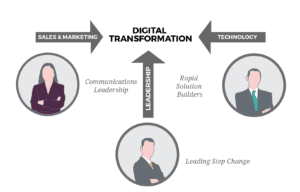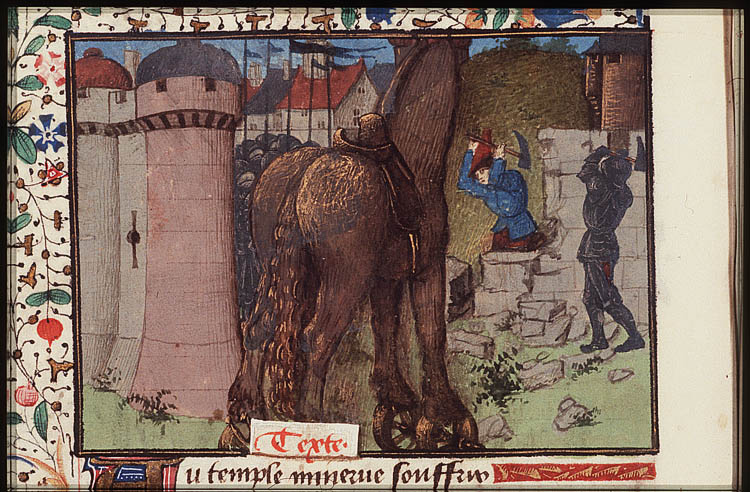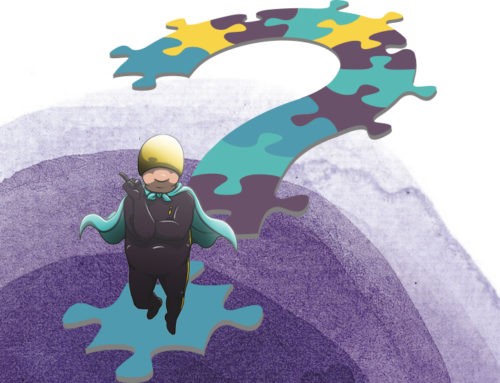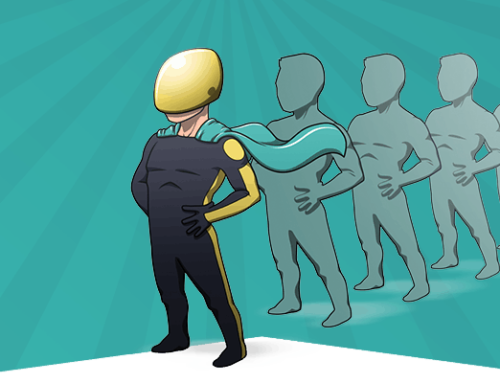Read First: What is Digital Transformation?
Myths serve many purposes; one of which is to explain the phenomena we observe in our environment. Digital Transformation myths have arisen in exactly the same way – from observing digitally successful businesses and attributing their success to a particular cause. In these instances however, that cause has been misdiagnosed.
These are our top 5 myths of Digital Transformation:
- Improving IT is Digital Transformation
- Improving operations is Digital Transformation.
- Improving digital marketing is Digital Transformation.
- All Digital Transformation Strategies are Good Strategies
- Lean, Agile, Sprints, Porter’s 5 Forces and so on create Digital Transformation Strategies.
Digital Transformation actually occurs when Technology, Marketing and Leadership converge.

To illustrate the point about myth origination we call upon the Greeks. When they witnessed the earth suddenly and rather violently cracking open before their very eyes they evidently thought a bit of explanation was in order. In lieu of knowledge of tectonic plates, a powerful invisible force (a God) was assigned responsibility, given a motive (huffy disposition), a manly name (Poseidon) and the means to do aforementioned damage (a trident). Job done. Suitable explanation created? Yes. Was it accurate? No, but the thought process makes sense. Our top 5 myths of digital transformation have some substance behind them.
Myth 1: Improving IT is Digital Transformation.
When it comes to Digital Transformation, IT is the delivery agent. We believe that in the digital age,
Strategy creates competitive advantage,
People and a culture of innovation sustains it, and
Technology and communications are the means by which it is delivered.
Our Greek friends provide another very useful illustration here. They once built a giant hollow wooden horse on wheels in which to hide a party of soldiers. They then tricked their enemies into willingly pulling this horse into the city they were trying to defend. Once in, our wily invaders lay hidden until their enemies passed out from excessive merriment before letting their chums in and rather forcibly taking over the place.
In this case IT = wooden horse.

Without Odysseus’s brilliant plan there would have been no horse. Even if the horse already existed, it was no doubt being used for something other than smuggling soldiers into a city. Said horse could have been more usefully employed as a tourist attraction (or maybe a gift to the Gods to prevent thunderstorms, who knows). The point is that it’s what they did with the horse that mattered. Everyone knows what a Trojan horse is, but be honest, did you remember Odysseus? No wonder people think cool tech creates Digital Transformation.
Myth 2: Improving Operations is Strategic Digital Transformation.
Improving operations is really about maintaining best practice, creating operational efficiency, improving processes. In our Trojan war analogy, operations is the equivalent of the army’s fighting skills. Once out of the horse and facing their enemies, they needed to know how to wield a sword with sufficient skill to kill their opponents. No use pulling off such a brilliant trick only to fall down because they were armed with spoons and trained to fight by grannies.
Myth 3: Improving Digital Marketing is Digital Transformation.
Marketing is communication and digital marketing is a communications tool in today’s digital age. Myths and legends have survived for thousands of years because they have top notch entertainment value or lasting relevant meaning. Myths have been passed down through the generations orally, they have been depicted on pottery and painted on walls, they have been turned into poems and songs, written in books and now they’re on the web.
Digital Marketing in a transformed organisation uses data to understand how we are currently perceived in the minds of our customers and how to communicate a value proposition that creates a shift in that perception.
Myth 4: All Digital Transformation Strategies are Good Strategies.
Richard Rumelt sets the gold standard in strategy and he would definitely approve of Odysseus’s strategy. According to Rumelt there are 3 elements to a good strategy:
- Diagnosis. (We need to get inside the city and we can’t get over or through those walls. We need to get in through the door).
- Guiding Policy. (We can hoodwink those Trojans into letting us in with a cunning plan).
- Coherent Plan of Action. (Build large horse, hide the rest of the ships around the corner and concoct convincing lie for Sinon that will result in the Trojans welcoming us with open arms).
We diagnose the situation by understanding the major challenges or obstacles facing the business. Our guiding policy is created by understanding and stating the rules that we are going to apply to best fix the problem or overcome the challenge. A coherent plan of action is then created based on that guiding policy. Strategy for the digital age still requires all 3 elements in what Rumelt calls a strategy kernel.
Myth 5: Agile, Lean, Sprints, Porter’s 5 Forces etc create Digital Transformation Strategies.
You could of course apply Lean, Agile or any other methodology to the building of a giant wooden horse. None of these, however, would tell you to build a horse in the first place. A Digital Business Strategy can identify a way of leveraging technology to help deliver competitive advantage. Odysseus might have come up with a horse but it could just as easily have been an ox, a goat, an elephant or even a giant lollipop if that were the most effective way into the city (if the greeks had lollipops of course, probably not. Come to think of it ‘Trojan lollipop’ lacks a certain gravitas, that legend probably wouldn’t have lasted the distance). The point is that any of these methodologies can be used to efficiently and effectively build a horse that meets your client’s needs.
To avoid these myths and falling into any of their associated pitfalls you first need a digital business strategy framework. This framework uses data to understand the digital marketplace dynamics of your industry, your place in that marketplace and the challenges you face in order to move. Then it’s up to you to decide whether you need a horse, a trident, an app, a robot or a giant lollipop to provide the solution.
If you would like to know more about how this is done, you can take this free digital transformation training course. Ionology has a range of consultancy, training and software options to help with your digital transformation process.


